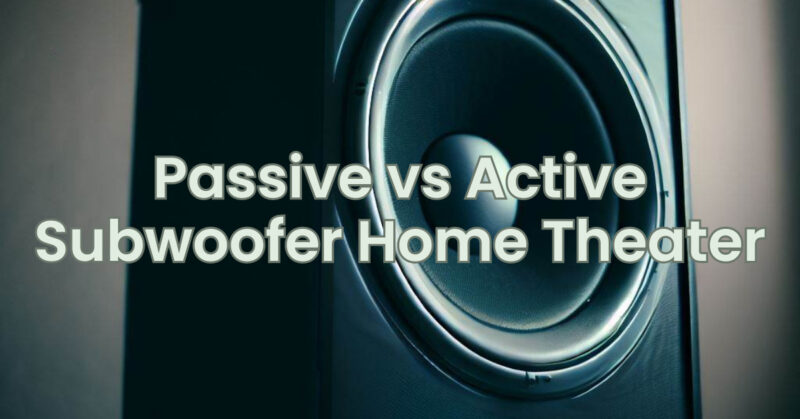When setting up a home theater system, one of the critical components for achieving immersive sound is a subwoofer. Subwoofers are designed to reproduce low-frequency sounds, adding depth and impact to your audio experience. In the realm of home theater, you have two main options: passive subwoofers and active subwoofers. Understanding the differences between these two types is essential in selecting the right subwoofer for your home theater setup. This article will compare passive subwoofers and active subwoofers in the context of home theater, highlighting their features, benefits, and considerations to help you make an informed decision.
- Passive Subwoofers for Home Theater: Passive subwoofers require an external amplifier to power them. Here are some key advantages of using passive subwoofers in a home theater system:
a. Amplifier Flexibility: With passive subwoofers, you have the freedom to select and match an amplifier that meets your power requirements and sonic preferences. This allows for greater customization and control over your audio setup.
b. Sound Quality: When properly matched with a suitable amplifier, passive subwoofers can deliver excellent sound quality and precision in bass reproduction, providing a well-integrated and balanced audio experience.
c. Expandability: Passive subwoofers offer the advantage of scalability. You can easily add multiple subwoofers to your home theater system, further enhancing the low-frequency impact and creating a more immersive environment.
d. System Integration: Passive subwoofers can be seamlessly integrated into existing home theater setups, allowing you to leverage your existing audio equipment and configurations.
- Active Subwoofers for Home Theater: Active subwoofers, also known as powered subwoofers, have a built-in amplifier and do not require an external amplifier. Consider the following factors when considering active subwoofers for your home theater system:
a. Simplified Setup: Active subwoofers offer a plug-and-play solution, as they come with a built-in amplifier that is specifically matched to the subwoofer’s driver. This eliminates the need to source and match an external amplifier.
b. Ease of Use: Active subwoofers often feature onboard controls and settings, such as volume, crossover frequency, and phase adjustments. This allows for easy customization and fine-tuning of the subwoofer’s performance according to your preferences.
c. Space Efficiency: Active subwoofers are typically compact and designed to fit seamlessly into home theater setups. They often come in sleek enclosures, making them easier to position and integrate into your room without occupying excessive space.
d. Dedicated Amplification: The built-in amplifier in active subwoofers is optimized for the specific subwoofer driver, ensuring optimal performance and power output.
- Factors to Consider:
a. Room Size and Acoustics: Assess the size and acoustic properties of your home theater room. Passive subwoofers with the right amplifier can provide more precise control over bass response in larger rooms, while active subwoofers may offer simplicity and ease of integration in smaller spaces.
b. Desired Sound Performance: Consider the level of customization and control you want over the bass response. Passive subwoofers can provide more flexibility for fine-tuning the sound, while active subwoofers offer convenience and ease of use.
c. Future Expandability: If you plan to expand your home theater system in the future, passive subwoofers may offer more flexibility in adding multiple subwoofers for enhanced bass impact.
d. Budget: Evaluate your budget for the subwoofer and associated amplification. Passive subwoofers may require an additional amplifier, which can add to the overall cost, while active subwoofers offer an all-in-one solution.
When it comes to selecting between a passive subwoofer and an active subwoofer for your home theater, it ultimately depends on your specific requirements, room size, desired sound performance, and budget. Passive subwoofers offer flexibility, expandability, and the ability to customize your setup with external amplifiers. Active subwoofers provide convenience, simplicity, and a compact all-in-one solution. Consider these factors carefully to choose the subwoofer that will best complement your home theater system and deliver the immersive bass experience you desire.


